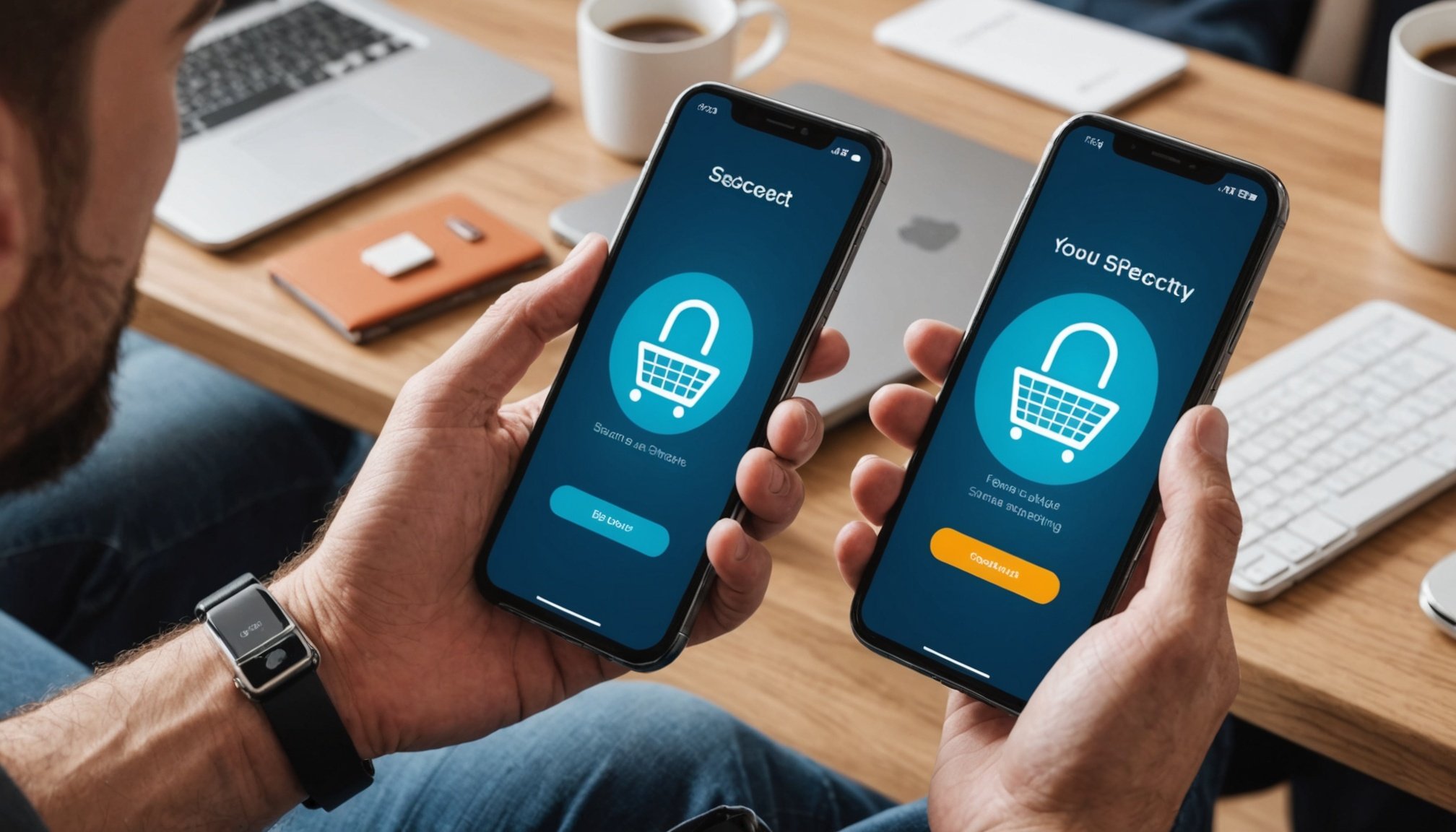Understanding the Importance of Smartphone Security
In today’s digital environment, smartphone security is critical, particularly with the growth of online shopping. As convenience increases, so do potential security threats. Smartphone users face numerous threats during online transactions, including malware attacks and data breaches. These risks emphasize the urgent need for robust security measures to prevent identity theft and safeguard personal information.
With the surge in online shopping, smartphone security has become even more significant. This digital lifestyle shift means more transactions occur via mobile devices, making them prime targets for cybercriminals. Users must be aware of the dangers of insecure networks and phishing scams that can compromise personal data.
Also to read : Dominate Your Device: Crucial Smartphone Settings to Elevate Your Gaming Performance
Personal data protection is paramount in this digital age. It is not just about shielding financial information; it also involves securing personal identities and maintaining privacy. Effective identity theft prevention strategies include using strong, unique passwords and enabling features like biometric security.
By ensuring stringent smartphone security, users not only protect their devices but also their personal and financial security while enjoying the conveniences of online shopping. Understanding these risks allows users to implement necessary precautions effectively, ensuring their digital peace of mind in a demanding cyber environment.
Additional reading : Supercharge Your Augmented Reality: Key Tips to Boost Your Smartphone’s Potential
Enabling Two-Factor Authentication
In today’s digital age, keeping your account security strong is paramount. Two-factor authentication (2FA) offers an added layer of protection, fortifying your mobile devices against unauthorised access. But how does it work? When you enable 2FA, logging into your account requires two forms of identification: something you know (like a password) and something you have (such as a phone or a fingerprint).
To set up two-factor authentication on your smartphone, begin by selecting a reliable app. Usually, settings allow fine adjustments such as enabling push notifications, ensuring convenience without compromising security. Next, link your app to accounts supporting 2FA. This often involves scanning a QR code or entering a code to verify the connection. Regularly updating and reviewing your 2FA settings is essential to maintain ongoing mobile protection.
For those new to this security feature, several apps like Google Authenticator and Authy offer easy-to-use interfaces. These apps enhance files transfer safety, making them integral for frequent online shoppers. Finally, remember 2FA isn’t a replacement for strong passwords but complements them for heightened security. Always remain vigilant and keep your backup methods updated to ensure comprehensive protection in the evolving landscape of account security.
Managing App Permissions
In the world of mobile app security, understanding and managing app permissions is crucial for maintaining data privacy. When apps demand unnecessary permissions, they can access more personal data than required, posing risks to user privacy.
App permissions dictate what information and features an app can access on your device. It is wise to routinely review these to ensure each app’s permissions align with its functions. Begin by navigating to your phone’s settings, then head to the app permissions section. Here, you can view permissions by app or by permission type, allowing transparent oversight.
To bolster mobile app security, consider these steps:
- Audit permissions regularly: Check for apps requiring access beyond their functional scope.
- Revoke excessive permissions: If an app asks for access unrelated to its purpose, deny it.
- Limit access to sensitive data: Restrict apps from accessing sensitive data unless absolutely necessary.
Exploring trustworthy apps is another step towards secure online shopping. Ensuring apps come from reputable developers guarantees a safer shopping experience. Even with trusted apps, vigilance in app permissions management remains vital, safeguarding your information from undue exposure and maintaining robust privacy on mobile devices.
Using Secure Wi-Fi Connections
In the realm of online shopping safety, using a secure Wi-Fi connection is a fundamental practice to protect your data. Public networks often pose security threats, making it critical to understand these risks. Cybercriminals frequently target these networks, exploiting their security weaknesses to intercept data. Public networks are not inherently secure, and any information transmitted over them could be susceptible to interception.
To ensure Wi-Fi security while shopping online, consider the following best practices:
- Use a Virtual Private Network (VPN): Encrypts your internet connection, masking your data from potential intruders.
- Avoid Financial Transactions on Public Networks: Refrain from conducting financial activities using public Wi-Fi to reduce the risk of data breaches.
- Verify Network Authenticity: Ensure you are connecting to a legitimate network and not a fraudulent one set up by attackers.
For situations where secure network access is challenging, consider alternative options such as your mobile data plan, which tends to offer more security than public Wi-Fi. By prioritizing secure internet access, you can significantly enhance your mobile protection and maintain online shopping safety. Implementing these strategies effectively mitigates risks and ensures your personal information remains private.
Regular Software Updates
In the fast-evolving world of mobile technology, keeping your smartphone software up to date is vital for maintaining device security. Regular software updates play a crucial role in enhancing mobile safety by providing essential patches that fix vulnerabilities and protect against emerging threats.
Each device security update addresses specific security holes that cybercriminals often exploit. By regularly updating your smartphone, you are effectively fortifying your mobile safety against potential breaches, considerably reducing the risk of malicious attacks. Updates may also offer new features that enhance the user experience or optimize smartphone performance.
To guarantee timely updates, consider these practical strategies:
- Automatic Updates: Enable automatic updates in your settings to ensure you receive the latest security enhancements without delay.
- Regular Checks: Manually check for updates if your device is set to be notified infrequently.
- Wi-Fi Connection: Make use of a secure Wi-Fi connection to download updates quickly and safely without incurring additional data charges.
By prioritizing software updates, you reinforce your smartphone’s defenses against cyber threats, ensuring that your device operates efficiently and securely. Continuous vigilance in keeping your software current will significantly fortify your mobile safety and protect your personal data in this digital era.
Recognizing Phishing Scams
In the digital world, phishing scams are a prevalent form of online fraud, especially during online shopping. These scams often masquerade as trusted entities to steal sensitive information. Recognizing these malicious attempts is vital for maintaining security awareness and protecting personal data.
Phishing emails typically exhibit suspicious characteristics. Common signs include urgent language, generic greetings, unexpected attachments, and requests for personal information. If an email purports urgent account actions or pressures for immediate response, exercise caution. Always scrutinize email addresses carefully, as scammers often mimic legitimate domains with slight alterations.
To enhance your security awareness, utilize specific tools and resources that can identify phishing threats. Security software with email filtering capabilities can effectively block phishing attempts. Browser extensions are also valuable, warning against visiting fraudulent sites.
When navigating links and emails, adopt meticulous habits for safely navigating the digital landscape. Avoid clicking on unknown links and double-check URLs before entering details. When in doubt, directly access the company’s official website instead of following email instructions. By incorporating these practices, you shield yourself from scams that could jeopardize your online shopping experience and personal security. Always remain vigilant and informed to fortify your defence against these persistent threats.
Using Secure Payment Methods
In the realm of online transactions, ensuring financial safety demands the use of secure payment methods. With cyber threats evolving, secure transactions are a top priority for safeguarding personal and financial information. Let’s delve into how choosing secure payment options can protect you against fraud.
Virtual wallets and payment services offer a robust solution, encrypting your details to shield them from potential breaches. Services like PayPal, Google Pay, and Apple Pay provide an additional layer of security, minimising the exposure of your card information during transactions. Benefits include not only enhanced security but also the convenience of contactless payments, reducing physical card handling.
When it comes to sharing payment information, vigilance is key. Always ensure the retailer’s website is secure—look for “https” in the URL. For enhanced safety, regularly monitor bank statements for unauthorised transactions. Precautions also include setting up transaction alerts with your bank, providing real-time updates and enabling swift action against fraudulent activity.
In sum, adopting secure payment methods and employing careful practices can significantly reduce the risk of fraud, granting peace of mind. Leveraging technology wisely to enhance security is essential in today’s digital marketplace.











